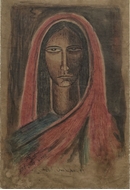![]() Significant Indian Paintings
Significant Indian Paintings
![]() Significant Indian Paintings
RABINDRANATH TAGORE (1861 - 1941)
Significant Indian Paintings
RABINDRANATH TAGORE (1861 - 1941)
RELATED LOTS
CONTACT US
Catalogue & Viewing
Lot Closed
Accounts & Shipping
Lot Closed
-
Provenance
 Provenance
Provenance
Acquired by the present owners, in the mid-1970s, from a retired teacher in Shantiniketan
-
Literature
 Literature
Literature

“I remain silent even as my pictures are. It is for them to express and not to explain.”
– Rabindranath TagoreIn the eve of one’s life, when a resigned submission rules over a fading spirit, Rabindranath Tagore, the world poet, saw a new naissance come into his life in the form of his painted imageries. Aged sixty and partially colour blind, Tagore began his journey as an artist,unperturbed by his physical shortcomings.
His explorations with image-making began fortuitously, while scribbling out words from manuscripts of prose and poems. On such occasions, the unrhythmic scribbles would disturb his poetic conscience that inadvertently, sought rhythm in verse as well as visual. Gradually he begun doodling images on the pages of these worksheets, which over a period of time took shape of independent forms like animals,birds, flowers, figures and whatever else that took the poet’s fancy. In his own words, Rabindranath described his paintings as 'my versification in lines' and confessed that he was '...hopelessly entangled in the spell that the lines cast all around me'.
There is no doubt that many of his drawings are informed by a strong feeling for rhythm, but apart from this affinity there is little in common between his poetry and his painting. The latter seemed to manifest a deeper and more obscure angle of his creative personality. He often combined the physical traits of different beings in a queer combination of appearances, loosely termed as Zoomorphic forms. Seen in this image, Lot No. 51 is a remarkable creature with distinct features of a bird with alert eyes, flowing long beak and a curved crest for a rhythmic riposte. Added to these are the peculiar elements of a camel-back hump, a pronounced fish-tail and two rounded heavy feet. Tagore explains this complexity of his image-making in his rumination - “First, there is the hint of a line, then the line becomes a form...this creation of form is an endless wonder. If I were a finished artist, I probably would have followed a preconceived idea in making a picture...but it is far more exciting when the mind is seized by something outside of it, some compulsive surprise element gradually assuming an understandable form.”
Inspired by numerous styles and art forms including folk items that he encountered during his numerous travel expeditions in India and abroad, the poet began to churn out some of the ingenious creations of Modern Indian Art. Among the sources that stimulated his imagination were the woodcut prints by the German Expressionists Max Pechstein and Ernst Ludwig Kirschner; Folk art of northern New Ireland, the Haida carvings from West coast Canada (British Columbia). The grotesque, the bizarre, the cruel and the sardonic - all that he scrupulously kept out of his writings sneaked out of his drawings. What began as just an impromptu doodling, developed into a fullblown obsession resulting in a staggering production of more than two thousand paintings in the last ten years of his life.
-
Notes
 Notes
Notes

National Art Treasure / Non Exportable


